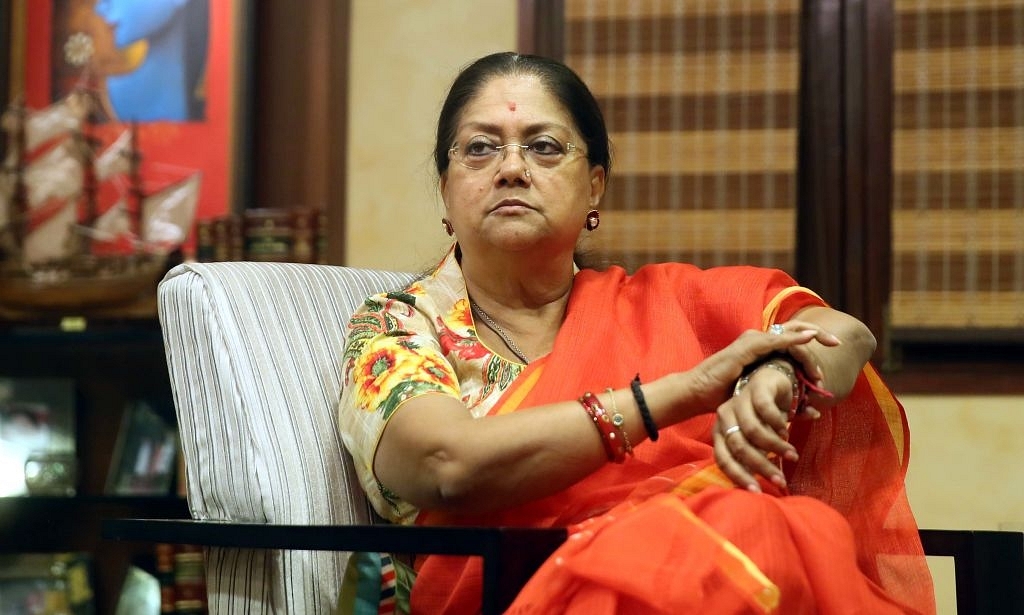
Vasundhara Raje: Daughter Of The Matriarch
What lies ahead for Vasundhara Raje?
On a day that Bharatiya Janata Party (BJP) has seen one of the worst political debacles in recent memory, the state of Rajasthan has surprisingly defeated the predictions of many pollsters. While the common sentiment was that the BJP will be trounced in the state, the incumbent Vasundhara Raje government has managed to hold on to 73 seats at the time of writing with a 39 per cent vote share.
This is certainly not a good news for the BJP or the chief minister because there has been a significant dent in the vote share since 2013-14, but considering the kind of backlash received in the past term, the number of seats can be considered as a small achievement. At the Centre of this discussion, is the controversial chief minister who is in equal amounts hated and celebrated in the state but undoubtedly is the one leader of the BJP who has led the most economically right wing government till date.
Raje was born in Gwalior, Madhya Pradesh in the Scindia royal family. Her mother, Vijaya Raje Scindia, who she also considers her role model, was a senior politician of the Bharatiya Jan Sangh and later the BJP. Vasundhara’s political career began in 1984, when she was made a member of the BJP’s national executive after which she went on to hold several key positions in the BJP in various capacities. She was first elected to the Lok Sabha from the Jhalrapatan seat in 1989, where she has been winning every election ever since. Even today, she managed to retain the seat in a contest with Manvendra Singh, who jumped ship to the Congress, by a margin of 34,000 votes.
She was made the Rajasthan BJP president in 2003. It is widely believed that it was on the insistence and efforts of Jaswant Singh and Bhairon Singh Shekhawat that Raje was given the task of heading the BJP in the state, a move widely considered controversial, by several analysts and BJP supporters alike. Part of the resentment against her was because Raje neither belonged to Rajasthan nor could speak the local language.
However, by steering the BJP to a 120 seat win in the 2003 assembly elections, Raje managed to silence her critics. Raje’s ascension to power also helped the BJP in winning support from both the Jats and the Rajputs as well as female voters.
The policy aspect of Raje’s last term has not received the attention that it deserves. Raje’s last term has been characterised by key reforms across sectors such as changing crucial labour laws, making it simpler for small enterprises to absorb more workforce, easing land acquisition rules to promote high economic activity as well as a string of major reforms in the agricultural sector. She has worked on creating a single agricultural market, permitting bulk purchase of farm produce and easing the procedures for farmers selling horticultural products.
Raje’s government further extended the scope of her reforms to the public distribution system (PDS) and in the power distribution sectors. In both these areas, the private sector was involved in order to revive the loss-making and inefficient public-sector ration shops (called Annapurna Bhandar) and power DISCOMS and make them profitable ventures.
Raje’s government also implemented major social welfare schemes like the Bhamashah Yojana, a uniquely Rajasthani scheme before the national Ayushman Bharat Yojana was launched, for efficient delivery of public services like affordable healthcare to the poor, Mukhyamantri Jal Swavlamban Yojana, a water conservation scheme and visible reforms in the education sector leading to an improvement in school enrolments in conservative regions like Shekhawati.
Numerous infrastructure projects have also been started along with capacity building enabled through central government initiatives like Swachh Bharat Abhiyan, ‘Skill India’, Pradhan Mantri Awas Yojana, in which Rajasthan has witnessed a huge number of toilets, training institutes and houses for the poor being built.
However, despite these big-ticket popular reforms and initiatives, Raje government was struggling in the face of massive anti-incumbency, Rajput angst against her government, the Rashtriya Swayamsewak Sangh’s (RSS) discomfort and Amit Shah’s alleged displeasure at her decision-making in the state. Her tenure was rattled by controversial encounters of Rajputs in the state, the controversy over the movie Padmaavat, all of which deeply offended the Rajputs, a crucial community in Rajasthan.
The miseries of her government got worsened by the widespread anti-incumbency against her among the public, who viewed her as an arrogant, aloof and indifferent leader and made her quite unpopular. However, Amit Shah’s clever election strategy this time focused upon mitigating the impact of anti-incumbency against Raje’s government by actively involving the RSS in the election campaigning as well as by shifting the focus of this election away from the turbulent tenure of Raje to the government of Narendra Modi.
The results are in and the reforms of the Raje government have not found favour among the people. This may be attributed to the nature of Rajasthan as a swing state which votes out the incumbent party every term or else it could be a larger comment on her likeability. But, she will leave her unique mark on the history of the state for the years to come.